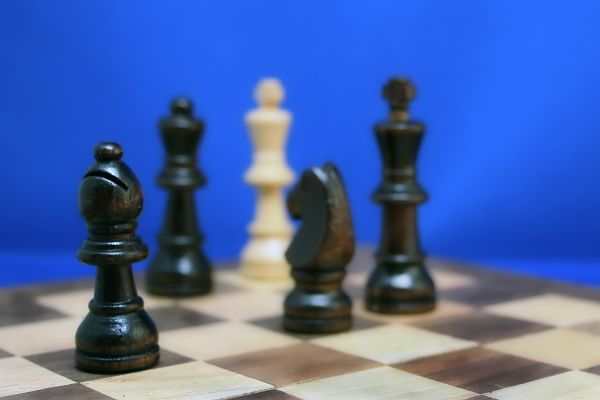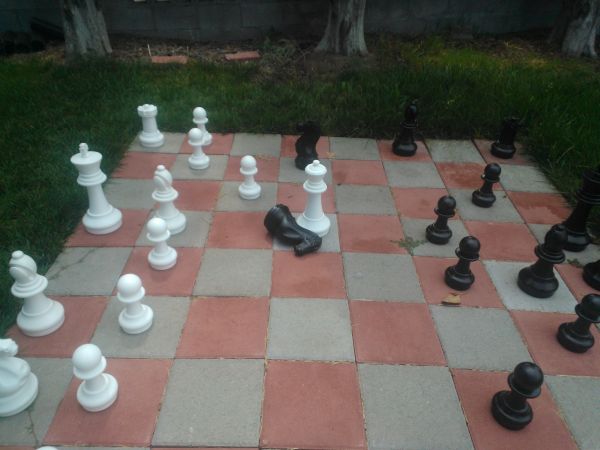The Closet Report: Chess

“Minutes to learn, a lifetime to master”
I am Jonathan Albin, the Game Market Guru, and this is the second installment of "The Closet Report," my in-depth and detailed analysis of tabletop games of every stripe. The Closet Report captures and outlines the merits, values, and details about these games in terms that a casual player or a die-hard veteran will appreciate, providing not only the "straight skinny" on the product in terms of the big 3 (Class, Character, and Creativity) but also in terms of Materials, Marketing, and Mechanics, as well as identifying areas of imagination, innovation, and ingenuity.
We focus this time on the time-honored and much-studied “game of kings,” Chess. This nigh-unto-ubiquitous classic represents a zero-sum attrition war game at its most abstract and elegant form. Utilizing a set move option for a limited number of playing pieces, and an abstract but effective reinforcement mechanic, Chess takes the very essence of limited warfare to its most basic form.
Overview
Game play requires little setup, and with the limited number of pieces used in the game (6 different piece types: Pawn, Bishop, Knight, Rook, Queen, and King) the basics are easy to pick up and understand. What is most interesting to me, as a game analyst, is the elegance of the multi-faceted nature of the game. For example, there is a clear allegorical allusion allowing the lowliest of pieces, the pawn, to have the sole potential for promotion — a form of reinforcement.
Chess has a fully-supported organized play program already in existence, so players, educators, and retailers interested in supporting or establishing clubs and organized play programs should contact the United States Chess Federation to learn more.

The game is readily available through many hobby retail stores, particularly those that carry classic, collectable, and family titles. It is currently available through most hobby distributors, including a great many fine manufacturers, including: Fritz Chess, Houdini Chess, ChessBase, Convekta, Chess King, The House of Staunton, Studio Anne Carlton, and Jaques of London
Below are the somewhat wonky, somewhat useful characteristics the Closet Report reveals about the product, and of its game play. As this is a Closet Report on a time-honored and tested game, it will prove useful in comparing products to products sensibly by providing a baseline for comparison. The Closet Report is based on casual play, not on competitive play, so the times and descriptions do not reflect the higher levels of organized play.
Statistics
-
Total Time to Play – TTP: 42:00
Total time including OBT, PT, and BiB. -
Out of the Box Time – OBT: 1:00
Time to open the box and set up pieces for the game. -
Play Time – PT: 40:00 for a casual game (longer time allowance for a regulation game)
Time from beginning of game to resolution, i.e., winner, draw, or quit. -
Back in Box Time – BIB: 1:00
Time required to put game back in the box configuration and return to the closet. -
Time Per Turn – T/T: 2:00
While not a requirement, Chess clocks allow a more competitive experience, and are required for sanctioned tournaments. -
Turns per Game – TPG: 40 or more
Number of turns in an average game. -
Turns to Engagement – TTE: 2-8 moves per player, depending on strategy.
While at the competitive level, it may be considered that every move engages, it seemed that it was between two and eight turns before player pieces were placed in jeopardy -
Fun Per Turn – FPT: 40%
Represents the rough percentage of the turn that feels like fun. In this case, I measured the amount of time it felt I was keeping with or ahead in determining my moves, the remainder felt like I was responding to my opponent’s actions. -
Work per Turn – WPT: 10%
Indicates how much of the turn feels like “work.” In this case, it represents how much of my moves felt like I had no other option, that I had to make specific moves to avoid jeopardy. -
Turns Before Fun – TBF: 8
The number of turns that must elapse before engagement with the other players occurs. In the case of this test game, it is the number of minutes before I put the first of my opponent’s pieces in jeopardy. -
Self-teaching time – STT: 12:00
The time it takes to learn the game by only reading the rules with no demonstration. In this case, the opponent learned how to move the pieces, but could not be said to have "learned how to play." -
Closet Time – CT: 4+ months, or until desire returns to be defeated soundly
Average length of time between plays.
Play Ratings
Numerical ratings from 1 to 10 on various aspects of the game. See each for a scalar definition.
-
Aggression (categorizes the rules by oppositional dynamics)
Scale from cooperative (1) to stridently adversarial (10) – Score: 8 -
Beauty (categorizes the rules by sheer aesthetics; is it “pretty”?)
Scale from functional (1) to art gallery quality (10) – Score: 8 -
Complexity (categorizes the rules by how easy or difficult to comprehend)
Scale from expected (1) to intricate beyond comprehension (10) – Score: 5 -
Depth (categorizes the rules in terms of subtlety)
Scale from shallow (1) to unbelievably nuanced (10) – Score: 7 -
Engagement (categorizes the rules in terms of player interaction)
Scale from parallel play (1) to strong need for teamwork (10) – Score: 3 -
Fun (categorizes the rules in terms sheer derived pleasure)
Scale from mildly amusing (1) to fall on the floor laughing (10) – Score: 4 -
Innovations Quotient (IQ) (identifies any characteristics that make the game unique)
Numeric rating, and each “point” is defined that make this product memorable – Score: 5
The innovation in this case was made centuries ago, so while they seem too common to count, I believe the thought that went into deciding the way pieces move and their allegory to medieval life is not only clever, it is eerily appropriate.
Miscellaneous
Breakout Events are the times and circumstances where this game may shorten its Closet Time, or otherwise help it "break out" of the closet.
- Chess is perfect for "breakout" when your friend that plays Chess well has had a bad day, and needs a few unbridled successes to pull him out of the funk. It always is good for playing on a coffee table when having a get-together with a generally non-gamer group, as even the least avid game aficionado knows how to move chess pieces around.
Shelf Rating is the overall game shelf rating, when compared with every other game in the closet. Scores will vary as new games come into being, and based on other characteristics such as marketing and promotions of similar games.
- By its heritage, history, and heft, the Chess set by nature most likely will earn a spot outside of the closet. Mine happens to be in my front yard (see the photo above). However, the age of the game, its presence as a bulwark in the game hall of fame, and the perception as the "Organized Play" elite will always keep it out of play rotation more than perhaps it deserves.






